Loss of a nucleophile - Study guides, Class notes & Summaries
Looking for the best study guides, study notes and summaries about Loss of a nucleophile? On this page you'll find 38 study documents about Loss of a nucleophile.
All 38 results
Sort by
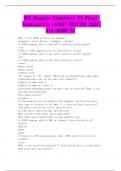
-
ACS Organic Chemistry II Final Examination LATEST EDITION 2024 AID GRADE A+
- Exam (elaborations) • 7 pages • 2024
-
- $9.99
- + learn more
What is the IUPAC priority for naming? Carboxylic acid > Ketone > Aldehyde > Alcohol In IUPAC naming, what is the suffix used for ketone groups? -one 6 Ways to Show Appreciation for Your Child's Teacher In IUPAC naming, what is the suffix used for alcohol groups? -nol In IUPAC naming, what is the suffix used for esters? -noate Benzyl group Phenyl group ethanoic acid (E) isomers vs. (Z) isomers. Which one is observed when the higher ranked molecules are on the same side? opp...
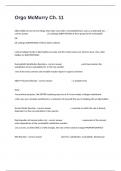
-
Orgo McMurry Ch. 11 Actual Questions And Answers Verified.
- Exam (elaborations) • 7 pages • 2024
-
Available in package deal
-
- $12.99
- + learn more
Alkyl halides do one of two things when they react with a nucleophile/base, such as a hydroxide ion... - correct answer (1) undergo SUBSTITUTION of the X group by the nucleophile OR (2) undergo ELIMINATION of HX to yield an alkene carbon-halogen bonds in alkyl halides are polar and the carbon atoms are electron-poor, thus, alkyl halides are ELECTROPHILES Nucleophilic Substitution Reactions - correct answer -each st...
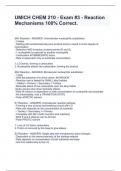
-
UMICH CHEM 210 - Exam #3 - Reaction Mechanisms 100% Correct.
- Exam (elaborations) • 3 pages • 2024
- Available in package deal
-
- $13.49
- + learn more
SN1 Reaction - ANSWER- Unimolecular nucleophilic substitution - 2 steps - Starting with enantiomerically pure product tends to result in some degree of racemization - Retention AND inversion at stereocenter (R and S) - 1 nucleophile is replaced by another nucleophile - Carbocation INTERMEDIATE forms - Rate is dependent only on substrate concentration 1. LG leaves, forming a carbocation 2. Nucleophile attacks the carbocation, forming the product SN2 Reaction - ANSWER- Bimolecular nuc...

-
Organic Chem Exam 3 Questions and Answers
- Exam (elaborations) • 9 pages • 2024
-
Available in package deal
-
- $12.49
- + learn more
alkyl halide - Answer-compounds in which a halogen is connected to an sp3 hybridized carbon atom 2 types of rxn's alkyl halides go under - Answer-substitution and elimination substitution reaction - Answer-when treated with a nucleophile, the nucleophile replaces the halogen elimination reaction - Answer-when treated with a base, a pi bond will form creating an alkene what functions does the halogen serve in an alkyl halide - Answer-1) halogen withdraws electron density leaving the ...

-
Science 0rganic chemiStry mechaniSm of a reaction
- Exam (elaborations) • 14 pages • 2024
-
- $17.99
- + learn more
Science 0rganic chemiStry mechaniSm of a reaction How do you get a disaccharide? - ANS-From the same reaction that gave us the glycoside! Its just that now the alcohol is.....ANOTHER MONOSACCHARIDE! YAY! What kind of bond does Cellulose have vs Starch and glycogen? - ANS-BETA 1, 4 vs the ALPHA of starch and glycogen (some α 1,6 in there too!) Basic structure of an Amino Acid - ANS- a central carbon atom attached to a hydrogen, an acidic carboxyl group (−COOH), an amino grou...
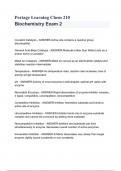
-
Portage Learning Chem 210 Biochemistry Exam 2 Questions & Answers 2023/2024
- Exam (elaborations) • 4 pages • 2024
- Available in package deal
-
- $7.99
- + learn more
Covalent Catalysis - ANSWER-Active site contains a reactive group (Nucleophile) General Acid-Base Catalysis - ANSWER-Molecule (other than Water) acts as a proton donor or acceptor Metal Ion Catalysis - ANSWER-Metal ion serves as an electrophilic catalyst and stabilizes reaction intermediate Temperature - ANSWER-As temperature rises, reaction rate increases; loss of activity at high temperature pH - ANSWER-Activity of most enzymes is bell-shaped; optimal pH varies with enzyme Reversible...
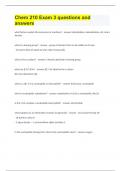
-
Chem 210 Exam 3 questions and answers
- Exam (elaborations) • 11 pages • 2023
-
Available in package deal
-
- $14.99
- + learn more
what factors explain the outcomes of reactions? hybridization, delocalization, eN, atom density what is a leaving group? - group of atom(s) that can be stable on its own - eN atoms that are good LG also make strong acids what is the α carbon? C directly attached to leaving group what are β Cs? β Hs? βC: C(s) attached to α carbon βH: H(s) attached to βC what is a LB? is it a nucleophile or electrophile? lewis base, nucleophile what is nucleophilic ...
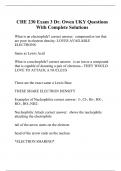
-
CHE 230 Exam 3 Dr. Owen UKY Questions With Complete Solutions
- Exam (elaborations) • 9 pages • 2023
- Available in package deal
-
- $11.49
- + learn more
What is an electrophile? correct answer: compound or ion that are poor in electron density- LOVES AVAILABLE ELECTRONS Same as Lewis Acid What is a nucleophile? correct answer: is an ion or a compound that is capable of donating a pair of electrons-- THEY WOULD LOVE TO ATTACK A NUCLEUS These are the exact same a Lewis Base THESE SHARE ELECTRON DENSITY Examples of Nucleophiles correct answer: I-, Cl-, Br-, HS-, RO-, HO-,NH2- Nucleophilic Attack correct answer: shows the nuc...
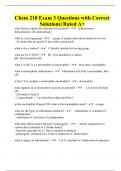
-
Chem 210 Exam 3 Questions with Correct Solutions| Rated A+
- Exam (elaborations) • 9 pages • 2023
-
Available in package deal
-
- $10.99
- + learn more
what factors explain the outcomes of reactions? - hybridization, delocalization, eN, atom density what is a leaving group? - - group of atom(s) that can be stable on its own - eN atoms that are good LG also make strong acids what is the α carbon? - C directly attached to leaving group what are β Cs? β Hs? - βC: C(s) attached to α carbon βH: H(s) attached to βC what is a LB? is it a nucleophile or electrophile? - lewis base, nucleophile what is nucleophilic ...

-
AAMC FL 1 FULL REVIEW- Chem-Phys Exam Questions and Answers
- Exam (elaborations) • 23 pages • 2024
-
- $13.49
- + learn more
AAMC FL 1 FULL REVIEW- Chem-Phys Exam Questions and Answers In the chromatography of the reaction mixture, water absorbed on cellulose functioned as the stationary phase. What was the principal factor determining the migration of individual components in the sample? A.Hydrogen bonding B.Solute concentration C.Stationary phase concentration D.Thickness of paper -Answer-B and D are dumb options. Knock them out. hydrogen bonding to the stationary phase will determine the relative rate of m...

How much did you already spend on Stuvia? Imagine there are plenty more of you out there paying for study notes, but this time YOU are the seller. Ka-ching! Discover all about earning on Stuvia


